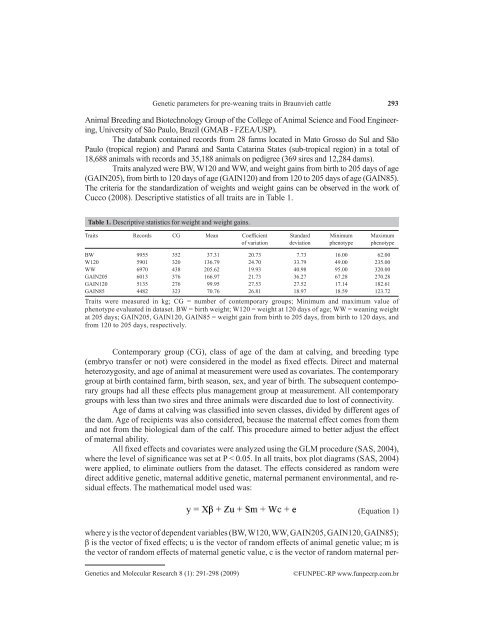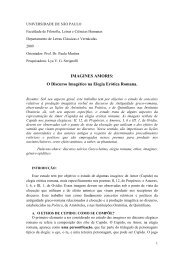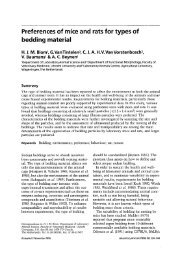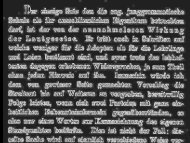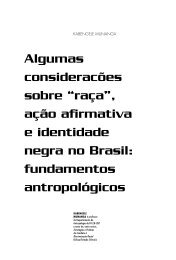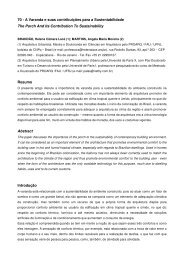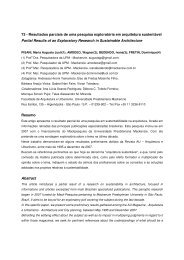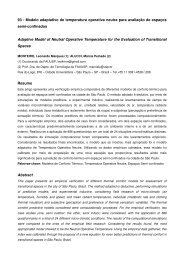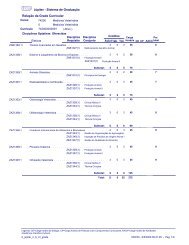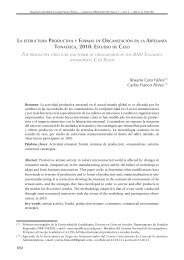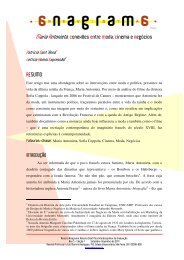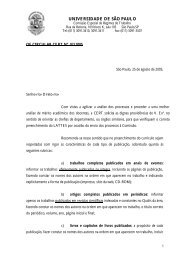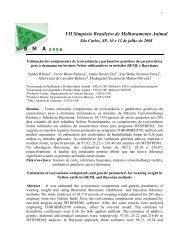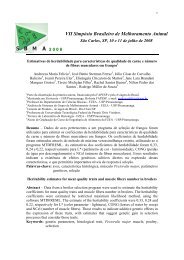D.C. Cucco et al.292improvement of Braunvieh cattle raised under tropical conditions.Key words: Beef cattle; <strong>Genetic</strong> and phenotypic correlation;Heritability; Maternal effect; Suizo cattle; Weight ga<strong>in</strong>INTRODUCTIONTo improve our genetic knowledge of cattle breeds, all phases of the development of theanimal should be studied <strong>in</strong> detail. This study supplies <strong>in</strong><strong>for</strong>mation that helps <strong>in</strong> the correct selectionof animals with better breed<strong>in</strong>g values. In this context, the <strong>pre</strong>-<strong>wean<strong>in</strong>g</strong> phase is of fundamentalimportance, where <strong>in</strong> this period the first records of per<strong>for</strong>mance can be collected and even thematernal ability and the maternal permanent environmental effects must be evaluated.Several per<strong>for</strong>mance <strong>traits</strong> are considered important from birth to <strong>wean<strong>in</strong>g</strong>. Birth weight(BW) is important because it can <strong>in</strong>dicate eventual problems <strong>in</strong> calv<strong>in</strong>g, where calves can be toobig or heavy. Studies <strong>in</strong> several breeds of beef cattle, <strong>in</strong>clud<strong>in</strong>g Braunvieh (Hagger and Hofer,1990), have <strong>in</strong>dicated that the selection of sires must avoid large breed<strong>in</strong>g values <strong>for</strong> birth weight,due to the high correlation with calv<strong>in</strong>g problems. Campos et al. (1986) studied the genetic andenvironmental effects on birth weight <strong>in</strong> Braunvieh-Guzerat animals and concluded that sex, ageof cow, and month and year of birth <strong>in</strong>fluence this weight.Dur<strong>in</strong>g this <strong>in</strong>itial development of the animal, when it still depends almost exclusively onthe cow’s ability to raise the calf, weight at 120 days (W120) is measured and this measure evaluatesthe maternal ability of the dam (Karsburg, 2003). The weight at this age is very dependent onmilk yield of the cow and it is little <strong>in</strong>fluenced by environment accord<strong>in</strong>g to Siqueira et al. (2003).However, there are not many studies on W120 <strong>in</strong> the literature.Wean<strong>in</strong>g, usually realized around seven months of age (around 205 days), <strong>in</strong>dicates theend of direct <strong>in</strong>fluence of the cow on the calf. It is very important to measure <strong>wean<strong>in</strong>g</strong> weight(WW) because approximately 50% of f<strong>in</strong>al weight is reached at <strong>wean<strong>in</strong>g</strong> (Everl<strong>in</strong>g et al., 2001).The growth of the calf is perhaps the most important factor <strong>for</strong> meat productivity <strong>in</strong> productionsystems (Corrêa et al., 2006). Weights and weight ga<strong>in</strong>s dur<strong>in</strong>g the <strong>pre</strong>-<strong>wean<strong>in</strong>g</strong> periodreflect the general ability of cows to raise their calves, but also reflect the capability of developmentof the animal (Mart<strong>in</strong>s et al., 2000).There are few reports about genetic <strong>parameters</strong> <strong>in</strong> Braunvieh cattle accord<strong>in</strong>g to Bennettand Gregory (1996). These authors published one of the only works with this breed;however, they reported results with an experimental herd. To get better results <strong>in</strong> selectionprograms, it is necessary to determ<strong>in</strong>e genetic <strong>parameters</strong> and per<strong>for</strong>mance of breed<strong>in</strong>g programs<strong>for</strong> each region (Cardoso et al., 2001).Thus, due to the shortage of studies <strong>in</strong> this area with Braunvieh cattle, especially <strong>in</strong> thetropics, and the need to estimate the genetic <strong>parameters</strong> <strong>for</strong> each population, this study aimed todeterm<strong>in</strong>e the heritability and genetic correlations <strong>for</strong> weights and weight ga<strong>in</strong>s <strong>in</strong> the <strong>pre</strong>-<strong>wean<strong>in</strong>g</strong>period <strong>in</strong> this breed. To better understand animal development and the maternal effects <strong>in</strong> the <strong>pre</strong><strong>wean<strong>in</strong>g</strong>period <strong>in</strong> Braunvieh cattle raised <strong>in</strong> the tropics, weight ga<strong>in</strong> was measured <strong>for</strong> differentperiods from weights determ<strong>in</strong>ed at 1, 120 and 205 days of age.MATERIAL AND METHODSThe dataset used came from the Nucleus of Braunvieh Breeders of Brazilian BreedersAssociation of Braunvieh and Brown Swiss Cattle - ABCGPS. Analyses were carried out <strong>in</strong> the<strong>Genetic</strong>s and Molecular Research 8 (1): 291-298 (2009)©FUNPEC-RP www.funpecrp.com.br
<strong>Genetic</strong> <strong>parameters</strong> <strong>for</strong> <strong>pre</strong>-<strong>wean<strong>in</strong>g</strong> <strong>traits</strong> <strong>in</strong> Braunvieh cattle293Animal Breed<strong>in</strong>g and Biotechnology Group of the College of Animal Science and Food Eng<strong>in</strong>eer<strong>in</strong>g,University of São Paulo, Brazil (GMAB - FZEA/USP).The databank conta<strong>in</strong>ed records from 28 farms located <strong>in</strong> Mato Grosso do Sul and SãoPaulo (tropical region) and Paraná and Santa Catar<strong>in</strong>a states (sub-tropical region) <strong>in</strong> a total of18,688 animals with records and 35,188 animals on pedigree (369 sires and 12,284 dams).Traits analyzed were BW, W120 and WW, and weight ga<strong>in</strong>s from birth to 205 days of age(GAIN205), from birth to 120 days of age (GAIN120) and from 120 to 205 days of age (GAIN85).The criteria <strong>for</strong> the standardization of weights and weight ga<strong>in</strong>s can be observed <strong>in</strong> the work ofCucco (2008). Descriptive statistics of all <strong>traits</strong> are <strong>in</strong> Table 1.Table 1. Descriptive statistics <strong>for</strong> weight and weight ga<strong>in</strong>s.Traits Records CG Mean Coefficient Standard M<strong>in</strong>imum Maximumof variation deviation phenotype phenotypeBW 9955 352 37.31 20.73 7.73 16.00 62.00W120 5901 320 136.79 24.70 33.79 49.00 235.00WW 6970 438 205.62 19.93 40.98 95.00 320.00GAIN205 6013 376 166.97 21.73 36.27 67.28 270.28GAIN120 5135 276 99.95 27.53 27.52 17.14 182.61GAIN85 4482 323 70.76 26.81 18.97 18.59 123.72Traits were measured <strong>in</strong> kg; CG = number of contemporary groups; M<strong>in</strong>imum and maximum value ofphenotype evaluated <strong>in</strong> dataset. BW = birth weight; W120 = weight at 120 days of age; WW = <strong>wean<strong>in</strong>g</strong> weightat 205 days; GAIN205, GAIN120, GAIN85 = weight ga<strong>in</strong> from birth to 205 days, from birth to 120 days, andfrom 120 to 205 days, respectively.Contemporary group (CG), class of age of the dam at calv<strong>in</strong>g, and breed<strong>in</strong>g type(embryo transfer or not) were considered <strong>in</strong> the model as fixed effects. Direct and maternalheterozygosity, and age of animal at measurement were used as covariates. The contemporarygroup at birth conta<strong>in</strong>ed farm, birth season, sex, and year of birth. The subsequent contemporarygroups had all these effects plus management group at measurement. All contemporarygroups with less than two sires and three animals were discarded due to lost of connectivity.Age of dams at calv<strong>in</strong>g was classified <strong>in</strong>to seven classes, divided by different ages ofthe dam. Age of recipients was also considered, because the maternal effect comes from themand not from the biological dam of the calf. This procedure aimed to better adjust the effectof maternal ability.All fixed effects and covariates were analyzed us<strong>in</strong>g the GLM procedure (SAS, 2004),where the level of significance was set at P < 0.05. In all <strong>traits</strong>, box plot diagrams (SAS, 2004)were applied, to elim<strong>in</strong>ate outliers from the dataset. The effects considered as random weredirect additive genetic, maternal additive genetic, maternal permanent environmental, and residualeffects. The mathematical model used was:(Equation 1)where y is the vector of dependent variables (BW, W120, WW, GAIN205, GAIN120, GAIN85);β is the vector of fixed effects; u is the vector of random effects of animal genetic value; m isthe vector of random effects of maternal genetic value, c is the vector of random maternal per-<strong>Genetic</strong>s and Molecular Research 8 (1): 291-298 (2009)©FUNPEC-RP www.funpecrp.com.br


